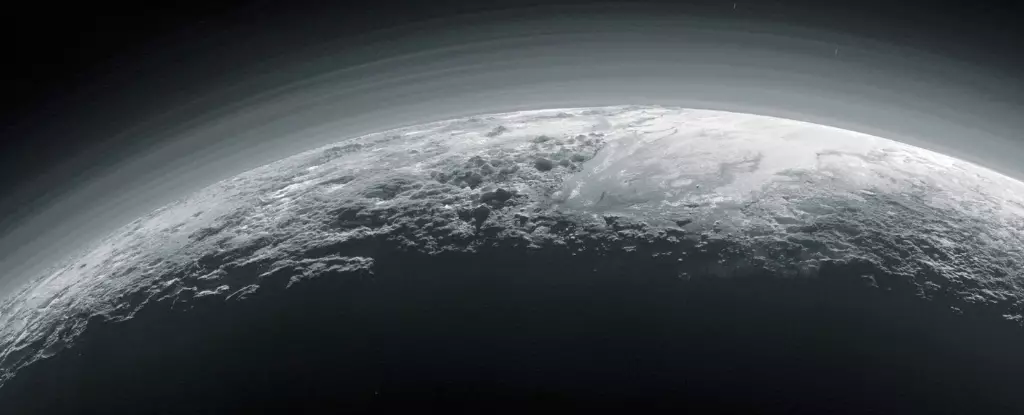When the New Horizons spacecraft made its historic flyby of Pluto in 2015, the world was captivated by extraordinary details revealing far more than we had anticipated. Not only did this mission provide vivid images of Pluto and its moon, Charon, but it fundamentally shifted our understanding of the Pluto-Charon system. Fast forward to recent advancements in astronomical technology, particularly the capabilities of the James Webb Space Telescope (JWST), and we find ourselves on the verge of a profound revelation about Pluto’s atmosphere that remains unparalleled in the Solar System.
The JWST’s observations taken in 2022 and 2023 have unveiled a radically different type of atmospheric structure on Pluto, one that exhibits qualities distinctly separate from those we see on other celestial bodies. The instrumental marvel has identified a haze made of nitrogen, methane, and carbon monoxide that doesn’t merely exist in static conditions; rather, it fluctuates in response to thermal changes, exhibiting a highly dynamic character that is quite extraordinary.
The Science Behind the Haze
The phenomenon of haze particles rising and falling due to varying temperatures presents an intricate interplay between energy balance and atmospheric composition, a process that has not been observed on other planets or moons in our Solar System. The crucial breakthrough came from a hypothesis proposed by astronomer Xi Zhang in 2017, which suggested that this thermal dynamism would lead to the generation of strong mid-infrared radiation detectable by advanced telescopes. This speculative notion was initially viewed as ambitious but was soon confirmed by the observational prowess of the JWST, much to the delight of the scientific community.
Zhang’s confidence in his prediction transitioned from a bet into a verifiable theory, underscoring the significance of hypotheses in planetary science. The speed at which this theory was validated, merely within a couple of years, is a rare event in the scientific realm, which often sees theories languish for decades before gaining empirical support. Such swift confirmation not only reflects the sophistication of modern observational technology but reinforces the importance of collaboration in scientific inquiry.
The Layers of Complexity in Pluto’s Atmosphere
The richness of Pluto’s atmosphere is underscored by the interaction of various gases that engage in complex photochemical processes, producing a haze that acts similarly to that found on Saturn’s moon, Titan. This active chemistry is a significant area of study as it enables researchers to draw parallels between extraterrestrial atmospheric phenomena. Initial investigations conducted by the New Horizons team were limited by the spacecraft’s observational scope, necessitating further surveys from the JWST to decode the full narrative of Pluto’s atmospheric behavior.
In 2023, researchers turned MIRI (Mid-Infrared Instrument) of the JWST back towards Pluto, focusing specifically on the mid-infrared spectrum. This strategic decision provided pivotal data that illuminated the intricacies of atmospheric and surface interactions on Pluto and Charon. Not only did the observations highlight variations in thermal radiation, they also facilitated a better understanding of the temperature dynamics tied to the regions across both celestial bodies.
A Unique Case in the Solar System
What makes Pluto’s atmospheric system particularly fascinating is the role of haze particles in maintaining radiative energy equilibrium. Unlike most other planets, where gaseous components typically govern this balance, Pluto showcases a peculiar scenario where particulate matter has a dominant influence. This characteristic positions Pluto at a unique frontier in planetary studies, allowing scientists to glean insights that could inform our understanding of Earth’s early atmosphere, which shared a composition similar to Pluto’s — rich in nitrogen and hydrocarbons.
In a twist of fate, studying Pluto could unravel the evolutionary paths of planetary atmospheres, revealing the conditions that contributed to making Earth conducive to life as we know it. The implications extend beyond mere academic curiosity; they touch on our fundamental quest to comprehend our origins in the cosmos.
Expanding Horizons in Planetary Science
The revelations about Pluto’s atmosphere through the JWST are just the tip of the iceberg. The complex dynamics at play highlight an imperative for continued exploration and analysis. Observations of Pluto may not only offer us a lens into the past but may also guide future explorations of other icy bodies, such as Neptune’s moon Triton or Saturn’s Titan, both of which contain similar atmospheric compositions.
In engaging with the uniqueness of Pluto’s atmospheric phenomena, we step into the field of planetary science with newly invigorated curiosity and ambition. Each observation and analysis creates a more comprehensive narrative around not just Pluto, but the broader spectrum of planetary atmospheres. By delving deep into the haze and mysterious dynamics surrounding this distant dwarf planet, we may unravel cosmic secrets that enrich our understanding of both the Solar System and the tantalizing possibilities of extraterrestrial life.

